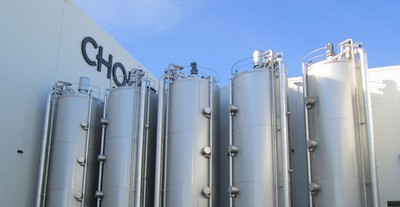
FORT WAYNE, Ind. — The Chobani Greek yogurt facility, which opened in October 2012 in Twin Falls, Idaho, and for which Shambaugh & Son, an EMCOR Company, performed the design-build and engineering and served as the general contractor, was named by Design-Build Institute of America the Design-Build Project of the Year, the organization's highest national honor. It was the second time DBIA recognized the Chobani project with a national award (it was the recipient of the DBIA Industrial/Process Facilities National Design-Build Award earlier in 2013).
 “We"re extremely pleased the Chobani plant has been recognized by the Design-Build Institute with its premier award. In conjunction with other awards this project has received, this is a testament to the Shambaugh team's ability to conceive, execute, and successfully and efficiently complete a highly complex, demanding project using design-build project delivery,” stated Mark Shambaugh, president & CEO, Shambaugh & Son. “This is the fifth time since 1997 the DBIA has awarded a food plant project designed, built and completed by Shambaugh & Son a Design-Build Project of the Year Award; it illustrates our national reputation for "design-build done right" and our unique self-perform executing method, which stands alone among our competitors.”
“We"re extremely pleased the Chobani plant has been recognized by the Design-Build Institute with its premier award. In conjunction with other awards this project has received, this is a testament to the Shambaugh team's ability to conceive, execute, and successfully and efficiently complete a highly complex, demanding project using design-build project delivery,” stated Mark Shambaugh, president & CEO, Shambaugh & Son. “This is the fifth time since 1997 the DBIA has awarded a food plant project designed, built and completed by Shambaugh & Son a Design-Build Project of the Year Award; it illustrates our national reputation for "design-build done right" and our unique self-perform executing method, which stands alone among our competitors.”
Lisa Washington, executive director and CEO of DBIA, stated: “The remarkable project for Chobani demonstrates the value of design-build project delivery. The benefits of design-build are manifested in the speed at which this project was completed and the quality of the final product.”
The $450-million, one-million-square-foot Chobani facility was completed in less than a year through Shambaugh & Son's use of design-build. The largest yogurt plant in the world, a facility of that size and complexity would traditionally require two years to complete. The plant was built sized to accommodate 14 production lines, 11 million pounds of milk per day and with infrastructure for future expansion. The team effort peaked at 1,000 workers, six days a week, divided in two 10-hour shifts to complete the facility in a record 10 months. The project achieved more than two million hours without a lost time incident.


 Join our thriving community of 70,000+ superintendents and trade professionals on LinkedIn!
Join our thriving community of 70,000+ superintendents and trade professionals on LinkedIn! Search our job board for your next opportunity, or post an opening within your company.
Search our job board for your next opportunity, or post an opening within your company. Subscribe to our monthly
Construction Superintendent eNewsletter and stay current.
Subscribe to our monthly
Construction Superintendent eNewsletter and stay current.